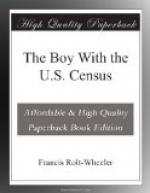“Of course not,” Hamilton replied, “I could have done it in half the time. What delayed things was riding from farm to farm, and they were scattered all over the countryside.”
“Exactly,” Barnes continued, “but I suppose you never stopped to think that the number of people in each district and the nature of the ground to be covered both had to be considered. Then allowance had to be made for the enumeration of those not readily accessible, and for such natural obstacles as unbridged rivers; all these had to be mapped out and gone over by the Census Bureau before the sections were assigned.”
“No,” the boy replied, “I never really stopped to think who it was that made up all those districts. And, now you come to speak of it, I don’t see how it could have been done without being on the ground.”
“Yet it is evident,” the other said, “that it must have been done. It wouldn’t be fair to tell a man to finish a district that represented seven or eight weeks’ work, nor to promise a month’s work to a man and then give him a district that had only two or three weeks’ employment. You couldn’t alter the districts afterwards, either, as everything had to be prepared in Washington for enumeration and tabulation by the original districts as mapped out.”
“You mean,” said Hamilton, “that every square mile of territory in the United States, the number of people on it, the kind of land it was, the roads and trails, the distance from the nearest town, the rivers, and the location of bridges across them, and all that sort of thing had to be worked out in advance?”
“Every acre,” was the reply, “and the worst of it was that there was very little to go by. The lists for the last Decennial Census were only of use in the Eastern districts, for in the West large towns had grown up that were mere villages then. Whole sections of territory which were uninhabited ten years ago are thick with farms today and the ’Great American Desert’ of a few years ago is becoming, under irrigation, the ‘Great American Garden.’”
“The Survey maps helped, I should think,” said Hamilton. “I have a friend, Roger Doughty, on the Geological Survey, and he told me all about the making of the Topographic maps.”
“They helped, of course, but even with those it was hard to work out some of the queerly shaped districts. The supervisors helped us greatly after the larger districts had been planned, but the Geography division had to keep in touch with every detail until the entire country was divided into proportionately equal sections.
“And you had to do that for Alaska, as well!”
“As far as we could. Of course it was difficult to determine routes of travel there, and to a large extent that had to be left to the supervisors, but they merely revised our original districting. It took a lot of figuring in Alaska because of the tremendous travel difficulties there and the thousands of miles of territory still unsurveyed.”




